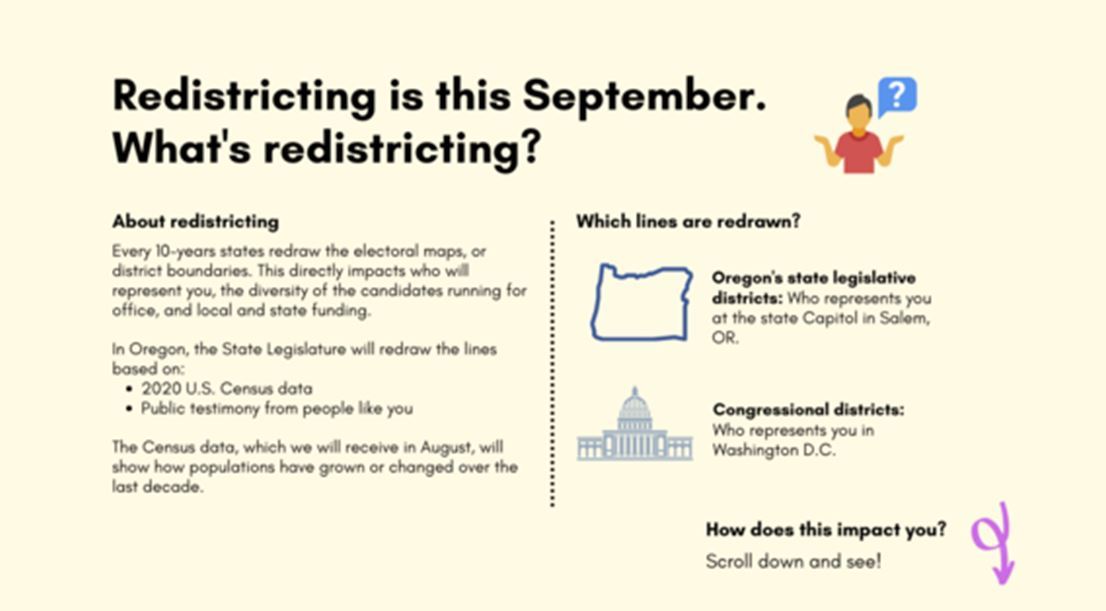
The process of redistricting is well underway this year. Required by the constitution once every ten years, redistricting ensures that political boundaries reflect population changes. One major development this year is that Oregon officially earned a sixth congressional seat, increasing our representation in Congress.
It's vital that Oregonians take part in the process of redistricting because of the impact it has on a variety of issues. Not only will legislators determine where to put Oregon’s sixth congressional seat, but all congressional and state legislative lines are subject to change. This affects who our elected officials can be for the next ten years, and influences local funding for things like emergency services, schools, and transportation.
That’s why you’re encouraged to take part in several public meetings across the state that will be held by the House and Senate Redistricting Committees. Your concerns can greatly influence how maps are drawn, and without your participation it will be harder to draw district lines that accurately reflect your interests. Oregon is at a high risk of gerrymandering this year which would favor one political party over another. Strong public participation can greatly reduce this risk.


House Republicans have an equal number of Representatives on the House Redistricting Committee and will be focused on the following statutory criteria per ORS188.010 to ensure a fair and honest process:
(1) Each district, as nearly as practicable, shall:
(a) Be contiguous;
(b) Be of equal population;
(c) Utilize existing geographic or political boundaries;
(d) Not divide communities of common interest; and
(e) Be connected by transportation links.
(2) No district shall be drawn for the purpose of favoring any political party, incumbent legislator or other person.
(3) No district shall be drawn for the purpose of diluting the voting strength of any language or ethnic minority group.
(4) Two state House of Representative districts shall be wholly included within a single state senatorial district.
To learn more about redistricting or one of the public meetings nearest you, visit: https://www.oregonlegislature.gov/redistricting
Redistricting 101
The United States Constitution requires a census every ten years to determine the number of people residing in each state. Once the population of each state has been determined, the 435 seats in the U.S. House of Representatives are redistributed based on population losses or gains in each state. This process is known as reapportionment.
Redistricting is the process of redrawing the district boundaries of state House, Senate, and Congressional districts. States take a variety of approaches to accomplish redistricting. Redistricting can be performed by the legislative, judicial, or executive branches, or by an independent commission. In Oregon, the state Constitution directs the Legislative Assembly to draw the district boundaries.
The Legislative Assembly draws maps to create districts that contain roughly equal populations for each of the three types of districts. In 2011, the ideal population for Oregon’s districts were as follows: 60 House districts of 63,851; 30 Senate districts of 127,702; and 5 Congressional districts of 766,215. By law, the U.S. Census Bureau must send the numbers of seats allocated to each state in the House of Representatives by December 31st of years ending in zero (i.e., 2000, 2010, 2020, etc.) to the President. No later than April 1st of the following year, the U.S. Census Bureau must send population data to the states. In Oregon, the Legislative Assembly has until July 1st of the year following a census to pass redistricting legislation. As with many other things, the unprecedented time we currently live in, this deadline was extended.
What’s important to know about the 2020 US Census
The census provides the basis for congressional apportionment, states’ votes in the Electoral College, and redistricting for congressional, legislative and local electoral districts. It also determines how much federal money gets distributed to the states and it shapes how businesses and policymakers make decisions.
The COVID-19 pandemic caused significant extensions and delays to the 2020 census operations. The self-response and field data collection operations for the 2020 Census ended on October 15, 2020. The apportionment data was delivered by April 30.
On April 26, 2021 the U.S. Census Bureau announced the apportionment results for the 2020 Census. We now know Oregon's total population, and that Oregon will receive a 6th congressional district.
- Oregon Resident Population: 4,237,256
- Average Population per Congressional District: 706,209
- Average Population per Oregon Senate District: 141,242
- Average Population per Oregon House District: 70,621
If you're a business owner, COVID 19 EIDL loans are still available through SBA. Click here to learn more or apply!

Governor Brown announced this week that masks will be requires statewide as of today, August 13th. Additionally, she announced all state workers must be fully vaccinated by October 18th of this year. I stand with Senator Fred Girod in his stance on this issue.

email: Rep.BillPost@oregonlegislature.gov I phone: 503-986-1425
address: 900 Court St NE, H-479, Salem, OR 97301
website: http://www.oregonlegislature.gov/post
|